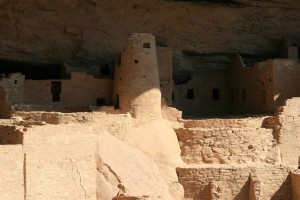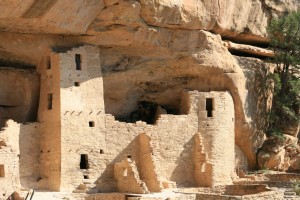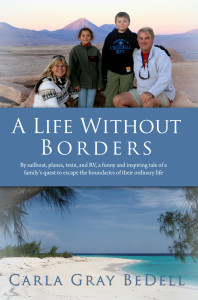Mesa Verde National Park was an enigma for us. We knew very little about the park, but we had heard about “cliff dwellings” and most would agree, some of the best preserved sites were at Mesa Verde. Getting simply to the first visitor center at Mesa Verde, 15 miles inside the park, was an achievement in itself. The road seemed to go straight up at times as we headed to 8500 feet. Around every curve, the narrow shoulder dropped off sharply to the valley below. Up here, you could see for miles. The trees eventually gave way to a much more rocky terrain, and later, at the very peak of the park, we could see the charred tree trunks and blackened limbs, the remains from a major fire in 2000, burning over 21,000 acres in the park.
Our first order of business was getting a campsite. Camping was always reasonable in a state park that was why we liked them so much. Plus, the campsites weren’t on top of one another, you felt like you had some privacy. The Morefield Campground was exactly what we wanted. All the full hookup sites were taken, but the campsites were large. The terrain was rocky with shrub trees, but in the late afternoon, herds of deer, Does with their fawns, crept their way to the edges of the campground.
At the Visitor Center, we signed the kids up for the Junior Ranger program, and reserved tours for the Cliff House later that day, and the Balcony House the next day. The Cliff House was the pride and joy of Mesa Verde. So much so, that you can only see it with a Ranger, on a group tour, with up to 65 people, in under an hour, and really not get that close. It was awful! Our group wasn’t that big, about 45 people. We gathered under the hot sun, at the top of the rim, straining to listen to the park ranger talk about mundane aspects of the park, and what we would see. He told us we would be heading down some steep steps, about 100 feet down, then as we left the Cliff House, we would head up a ladder about 8 to 10 feet. The tour would last an hour. It didn’t take a genius to figure out with this many people, going down and up, we would have very little time at the site itself. That’s exactly what happened. After descending the steps, we were told to stop just outside the dwellings, to wait for everyone to catch up, and to let the previous group already at the site, clear out. As we waited, our guide told us a little history. It was originally settled by the Ancient Puebloans. The Ancient Puebloans were for centuries referred to as the Anasazi, which was a derogatory term given them by the Navajo. It meant Ancient Enemy, so now, in the world of political correctness, the name has been changed to Ancient Puebloans. The site is not entirely as it was originally. Years ago, the park service hired an archeologist to fix up the ruins, and you can see his “repairs.”
As we were finally allowed to walk on the site, our guide admitted that not much is known about Cliff House, built in the 1200’s AD, as far as what it’s purpose was. Two theories: one that it was a living quarters, the second that it was administration, maybe storage. We were allowed very limited access to the site. We weren’t allowed to touch the walls, and had to stay huddled together which was very annoying, especially after having nearly total freedom at Machu Picchu. From what we could see and feel, we agreed with the theory that this was an administration area. One thing our travels in Peru had taught us was to “feel” the place as well as look at it. Cliff Palace faced west, not east. If people actually “lived” here, instead of “worked” here, their homes would not get light until late morning when the sun could make it over the rim. Second, it just didn’t have a good feel to any of us. That’s hard to explain. When you visit several historical sites, like we had in Peru and some in the US, and you’re allowed as much time as you want to wander around and really “feel” a place, you will feel the emotional footprint left by the inhabitants. Cliff Palace felt cold to us. Not welcoming. My guess was that it was a hospital or a prison, if they had such a thing. But none of us got a warm fuzzy feeling from it. After a ten minute lecture while actually standing in front of Cliff Palace, our time was up and we were hurried up the ladder and out of the site. The most disappointing tour I have ever been on.
Our Cliff Palace tour was so disappointing that we almost didn’t go on the Balcony House tour the next day. But since we already paid, and the kids needed it for their Junior Ranger badges we decided to go. We are so glad we did! What a great tour. Yes, it was ranger led, but this early morning the group was smaller, only about 15 of us, and the tour involved crawling through a short cave, climbing up 60 feet on steps carved into the rock face, and then up a ten foot ladder. Yes!! Our ranger was fantastic. Again, he admitted they didn’t know what the purpose of Balcony House was, but it was a general consensus it was living quarters. That felt right. It faced more towards the east and the feeling was lighter. He showed us the Kiva. A Kiva is a gathering/ceremonial center. It is dug deep into the ground, has a firepit in the center, and is covered with tree branches. In ancient times, families would gather here for warmth and ceremony. Our guide also showed us the elaborate heating system the Ancient Puebloans devised to move heat and air throughout the Kiva. It was amazing to see how inventive they were! Because our group was small, we were allowed to walk all around the site. To see this site up close, actually touch places where the Ancient Puebloans had touched so long ago was great. To have more time, to just sit and take in the site, was priceless. We were so glad we didn’t miss this tour.
We spent the rest of that day touring the other sites, like Spruce Tree house, that you could visit on your own. You could even climb down inside a Kiva here. The kids needed to visit most of the sites to finish their Junior Ranger books and earn their badges. It seems the further east we went; the harder it was to earn the badges. They had to visit most of the sites, and answer questions about them, identify animal and plant life, and a lot more. It was impressive to see how much they were learning. As we were driving, we passed a coyote on the road and stopped to take pictures. He was as curious about us as we were about him and came up close to the RV. Deer were very plentiful and we saw the occasional elk. When we got back to the campsite that night, the deer were enjoying a late afternoon feeding.
That night in the campground, I finished the dishes and looked out the RV window. The fire was started and the kids were huddled around it, trying to keep warm. I grabbed the marshmallows and headed out into the cold. Dan had his book light on, trying to read in the pitch blackness, and Tessa and Tristan gave me excited smiles anticipating the S’mores. I looked up and see the thousand of stars above and my heart fills with happiness. This was why I was here, to experience life, to see the world, to see nights like this with my husband, my children. I forget that sometimes. I get so caught up in other things or other people’s perceptions and I forget what a gift God has given me. To have this time, to spend with my family, to see an amazing sky filled with stars, if I had no money tomorrow, it would have all be unbelievably worth it. I give them each a hug and tell them how glad I am that we are all here together. They smile back and reach for the marshmallows.



